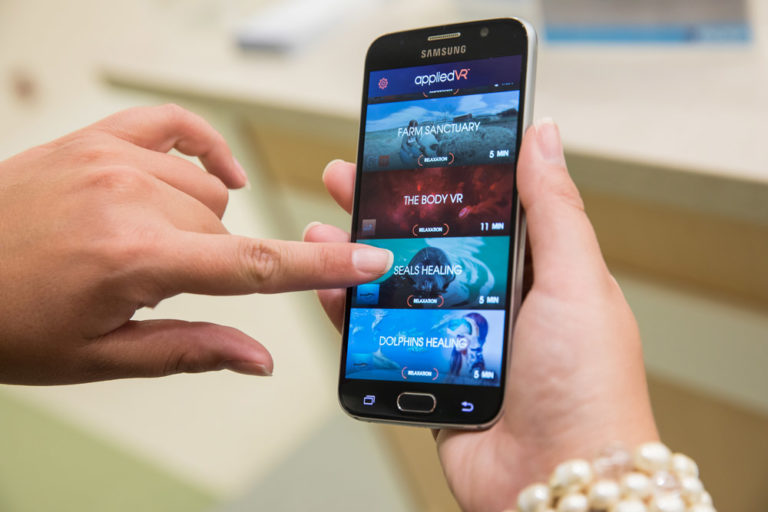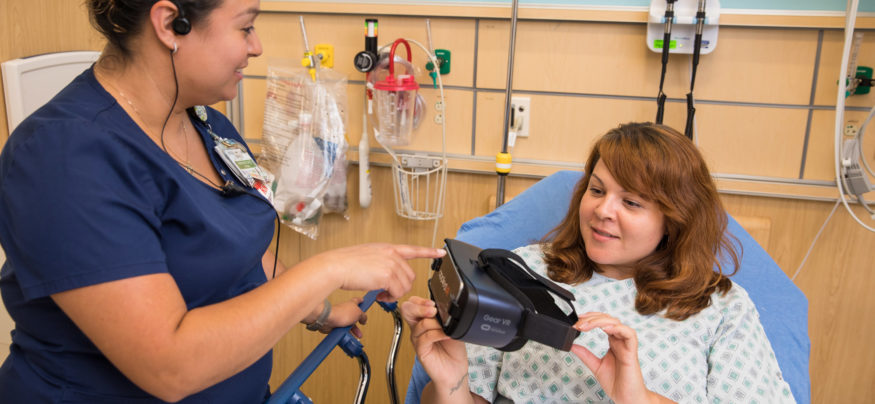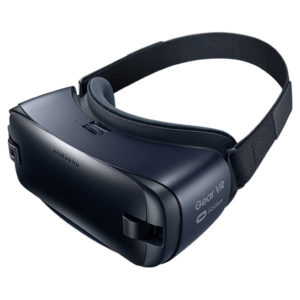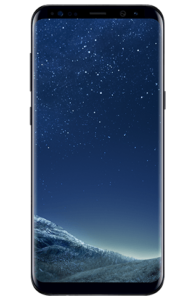
The Challenge
Like in most hospitals, physicians at Inova Mount Vernon Hospital, a nationally recognized community hospital in Alexandria, Virginia, are always looking for non-pharmacological ways to reduce the anxiety and pain their patients are facing. When strategy and growth officer, Thomas Pianta, read about the use of virtual reality in healthcare for anxiety and pain management, he decided to make this solution available in the newly overhauled emergency department — one of the most challenging areas of any hospital for innovation.
The Solution
Inova Mount Vernon Hospital now uses AppliedVR kits in two emergency departments, which are locked down using the Samsung Knox Custom Configurator so they only run the AppliedVR solution. Each kit includes a Samsung Gear VR headset, headphones and a Samsung Galaxy smartphone loaded with the AppliedVR platform — which includes an extensive library of guided meditations, 360-degree tours of beautiful locations and immersive games meant to distract patients during and after medical procedures.
"Over the past few decades, hundreds of studies have shown how VR provides positive clinical outcomes."
— Josh Sackman, CEO, AppliedVR
The Results
Inova Mount Vernon Hospital has only had the AppliedVR solution in place for a short period of time, but is already seeing its potential. Key benefits the hospital has seen as a result of implementing the AppliedVR kits include improved health outcomes, an enhanced patient experience, reduced costs and a stronger competitive differentiation in the marketplace.

Inova Mount Vernon Hospital is a 237-bed community hospital in Alexandria, Virginia. Situated on 26 acres of beautifully landscaped open space, Inova Mount Vernon offers patients a serene environment and top-notch care from nearly 10,000 highly-trained healthcare professionals. In 2016, the hospital opened the Veatch Family Emergency Department, a state-of-the-art facility with 35 all-private treatment rooms, new “fast track” rooms for less serious injuries, new cardiac emergency rooms and a specialized pediatric treatment area. Among its many accolades, the hospital has earned a Joint Commission Gold Seal of ApprovalTM for stroke care and the “Guardian of Excellence” award for patient satisfaction.
The Challenge:
Improving the Patient Experience While Reducing Costs
Introducing new technology in a hospital can be tough, especially in the emergency department. Nurses and physicians are already overburdened and tend to resist additions to their workflow, unless those solutions are convenient and have clinical value. Managing anxiety and pain without medication certainly adds value. And that’s exactly what Thomas Pianta thought when he read about virtual reality in healthcare.
As strategy and growth officer for Inova Mount Vernon, Pianta is responsible for bringing technological innovation to the award-winning hospital and its new state-of-the-art emergency department. “A lot of my work is focused around just reviewing the landscape and finding out what’s out there in terms of the latest technology,” says Pianta. “I wasn’t really looking for a problem to solve, just staying up to date on options.”
Pianta points out that ER visits and hospitalization can be stressful, especially for children, and that pain is one of the chief complaints from patients. “Pain and anxiety can have negative effects on the patient experience and health outcomes,” explains Pianta. “If we can help control that without giving medication — which just introduces new risks — that speaks for itself.”
During this research, he came across an article about AppliedVR, the first virtual reality platform designed to help manage pain and anxiety in a clinical setting. So, Pianta called the CEO of AppliedVR, Josh Sackman, who sent him a comprehensive list of research demonstrating the clinical value of virtual reality in healthcare, including compelling data from a research study from AppliedVR.
“The literature convinced me it was worth giving it a try,” says Pianta. “However you want to look at it, VR is a fairly low-risk intervention with a potentially really high positive yield.”
“It’s almost as simple as putting the goggles over the patients and letting them do it. It’s easy to use, so it hasn’t really been a challenge.”
— Dr. Everett Embrey, chairman of the emergency department, Inova Mount Vernon Hospital
The Solution:
VR for Patient Anxiety and Pain Management
Inova Mount Vernon Hospital now uses AppliedVR kits in its newly-overhauled emergency rooms in both Alexandria and Lorton, Virginia and its free-standing emergency department, Inova Wharton Healthplex.
Each kit includes a Samsung Gear VR headset, headphones and a Samsung Galaxy smartphone loaded with AppliedVR’s platform — which features an extensive library of guided meditations, 360-degree tours of exotic locations and immersive games meant to distract patients during and after medical procedures. Using the Samsung Knox Custom Configurator, AppliedVR locks down the devices so they only run the virtual reality solution.
“When we first brought the device to the emergency unit, we actually had a nurse on staff who was having an anxiety attack,” recalls Pianta. “We sat her down in the director of the emergency department’s office and put the headset on her, and she calmed down almost instantaneously. That really got the staff excited about it.”

Now, when a patient comes into the emergency department who might be a good candidate for the solution, the staff introduces the technology, selects the appropriate content on the smartphone and puts the headset and headphones on the patient.
Pianta points out that not every patient is a good candidate. “We don’t want to add anything to the situation that doesn’t have a reason to be there,” he says. “This is a medical intervention, not just entertainment, and not everybody in the emergency department is experiencing anxiety or pain. So, with help from AppliedVR and our nursing director, we’ve trained the staff to determine which patients are the best fit.”
Dr. Everett Embrey, chairman of the emergency department at Inova Mount Vernon Hospital, says the solution has been particularly useful with pediatric patients. “Children tend to be concerned about whether they’ll get stuck with a needle or whatever might happen to them, and even something like putting an IV in or cleaning a wound can make them more anxious than adults. Using the virtual reality equipment really helps relieve their stress and anxiety.”
According to Dr. Embrey, the staff in his emergency department are “very engaged” with the new technology, and he has not received any pushback. “It’s almost as simple as putting the goggles over the patients and letting them do it. It’s easy to use, so it hasn’t really been a challenge.”
AppliedVR CEO Josh Sackman gives Pianta and the Inova Mount Vernon staff much of the credit for a successful launch. “The emergency department is one of the most complex places to innovate and implement new practices into,” says Sackman. “The fact that they’re able to do that is really remarkable. It’s incredible to see the technology used in a place where it can create value but has a lot of barriers to implementation.”
The Technology:
Samsung Gear VR
Gear VR
Dive into a world of 360-degree experiences by snapping on the portable and wireless headset powered by Oculus.
Galaxy S8
Offering intuitive connectivity and defense-grade security for a seamless experience, the Galaxy S8 allows you to get more done in work and life.
The Results:
Improved Pain Management and Reduced Costs
Inova Mount Vernon Hospital has used the AppliedVR solution for a short period of time and “we’re still getting staff used to it,” says Pianta. “Next, we’ll design a trial that shows the true clinical efficacy.”
In the meantime, hospital staff has already noticed several key benefits. So, what’s the value of virtual reality in healthcare?
- Improved pain management: Using the distraction of virtual reality as an anxiety and pain management tool in place of medication is not only providing positive results for pediatric patients but adults as well. “I think it would also be really helpful in adults who are particularly anxious, and more and more EDs are looking for ways to treat pain without using narcotics, given the opioid epidemic in this country,” says Dr. Embrey.
- Reduced costs: Using virtual reality in healthcare can reduce patients’ length of stay and associated costs. “If you can reduce somebody’s anxiety before a procedure, or have a non-pharmacological tool to help manage their pain after the procedure, perhaps you can get them from IV to PO drugs faster, and get them ambulatory more quickly and eating sooner,” says Sackman. “These are all drivers of length of stay.”
- Better patient experience: “All the patients and parents we’ve spoken with have given very positive feedback,” says Dr. Embrey. “Anything we can do to improve the patient experience is important, not only because they’re surveyed and hospitals are reimbursed based on that, but because they’ll remember the good experience they had with virtual reality at Inova Mount Vernon and tell others about it.”
- Stronger competitive advantage: As insurance deductibles get higher and consumers get more research-savvy, healthcare systems must increasingly compete for patients. “Convenience and cost are certainly factors when patients seek care these days,” says Sackman. “But often their decisions are guided by Yelp scores, Health Grade and referrals and personal experiences, so improving the patient experience with VR technology can be a driving differentiation in the marketplace.”
Inova Mount Vernon Hospital is just ramping up, but nearly 50 hospitals nationwide are using the AppliedVR platform to better manage pain and anxiety, and improve the patient experience.
“Over the past few decades, hundreds of studies have shown how VR provides positive clinical outcomes,” says Sackman. “But the technology weighed 20 pounds, was tethered to a computer and cost nearly $50,000 for an installation. Now, thanks to consumer-grade VR technology from companies like Samsung, we finally have the chance to harness this amazing technology and all these years of research and implement it in a scalable way.”










